Oh Deer!
Fallen leaves carpet the ravine behind our home, broken only by thick green stems of bamboo, taller than most of our trees; a few young pawpaw and scarlet buckeye trees; and the thick trunks of century old beech trees. There are also a few fallen, decaying trunks of trees lost to storms, but none of the undergrowth you might expect to find in a wild ravine bordering a small lake. The soil is rich and deep. Dappled sunlight illuminates this area even in the summer. So where are all the seedling trees, shrubs, and flowering perennials that should be growing here?
I turn and make my way back up the steep slope of my back yard, surveying evergreen ferns gnawed down to their crowns, my Camellia shrubs stripped of their evergreen leaves, and even strands of poisonous English ivy nibbled back to its woody vining stems. There is little living vegetation left untouched. Only the thick, glossy leaves of hellebores, also highly poisonous, and a mature Magnolia tree. Further up the slope are a few native holly trees growing from bird-sown seeds, and some young firethorn shrubs.
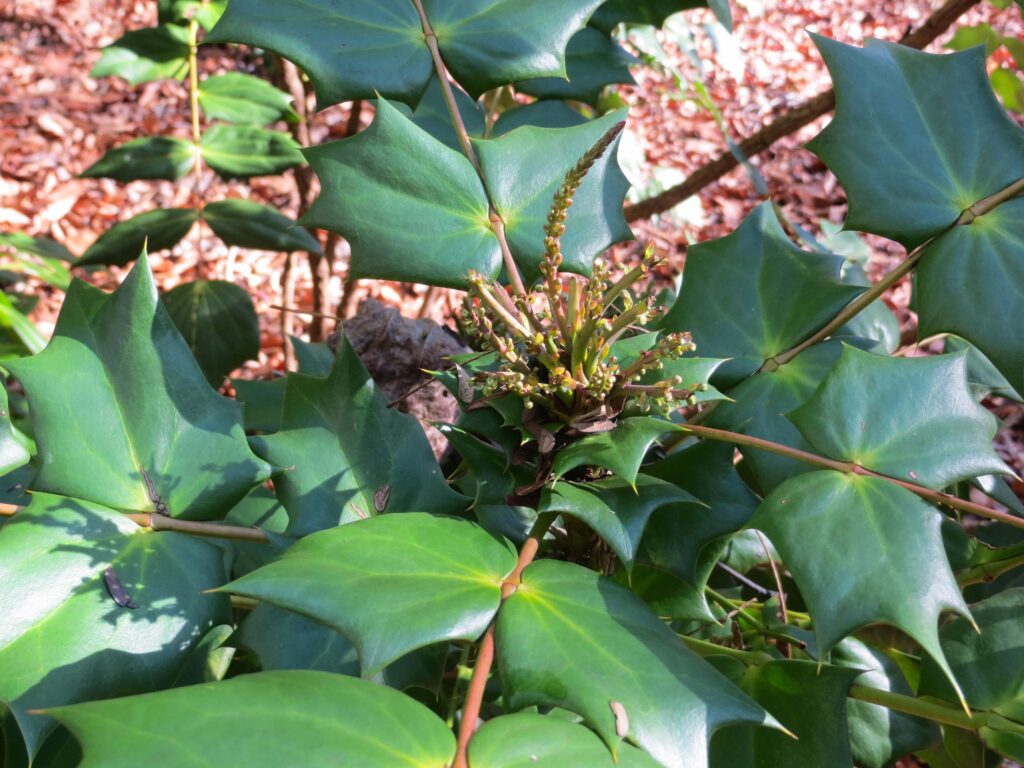
Berberis bealei, known as Mahonia or grape holly, rarely loses a single leaf to grazing deer. Their winter flowers are softer and easier to graze.
The leaves are still mostly intact on our spiky Berberis bealei shrubs, known as grape holly, but their clusters of yellow flowers are gone as far up as the largest bucks can reach. Only those clusters growing high above the ground are left to bloom as winter forage for the bees and to eventually ripen into spring fruits for the squirrels and birds.
Never Enough Food for Wildlife in Winter
The deer that roam our yard and neighborhood ravines are more desperate for food this winter than most. There was no mast from beech or oak trees in our yard this year, and I saw few acorns or beech nuts elsewhere in our neighborhood or along the Colonial Parkway. So, the ever-hungry deer are eating things they often ignore, like the ivy and poisonous Nandina shrubs. They are also stripping evergreen leaves away much earlier in the season than usual.
Deer are mainly herbivores and will eat a wide variety of vegetation including leaves, twigs, fruit, acorns, and grasses. When populations grow too large, they strip whatever vegetation they can reach, consuming food and destroying habitat needed by songbirds and other small mammals. They consume many types of small shrubs and seedling trees. The woodland habitat is mostly eaten and so never allowed to re-grow. Native wildflowers like Trillium, bloodroot, and Solomon’s-seal never have the chance to grow large enough to produce seeds.
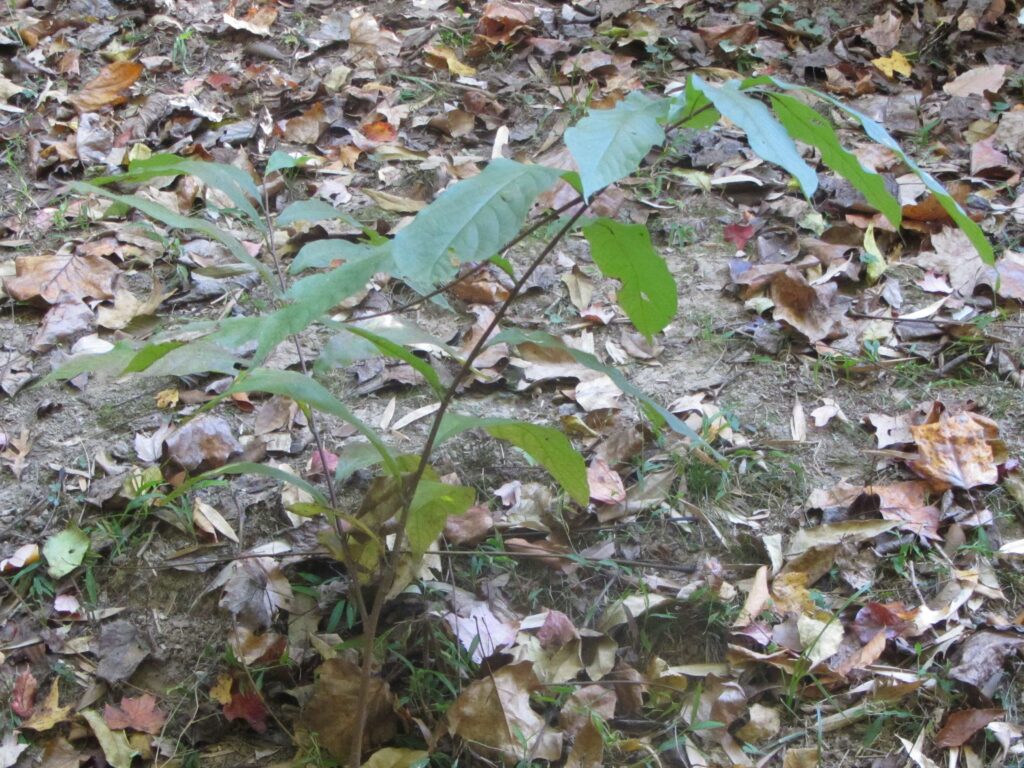
A young pawpaw tree, Asimina triloba, emerges from the roots of nearby mother pawpaw trees. Deer find their leaves distasteful and rarely graze on pawpaw. This young tree will survive. Ripened fruit in August and September will attract the interest of deer, however.
Deer Prevent the Regeneration of Native Trees
Mature trees can often withstand grazing deer, but not young seedlings. Most of last summer’s seedling trees were grazed months ago. Even young oaks grown in containers from gathered acorns didn’t survive their first year. While deciduous trees with tender leaves disappeared, young red cedar, American holly, and Southern Magnolia survived. Loblolly pines generally survive to grow, as well.
Even when young trees, five to twenty-odd years old survive grazing and replace their lost leaves, rubbing bucks may destroy enough bark on their trunk to kill them. We lost a young Magnolia tree to rubbing last year. Every leaf turned brown after its bark was damaged by a vertical gash rubbed into its young trunk, which also broke off a few branches. Mature bucks mark their territory by rubbing the bark on trees with their antlers.
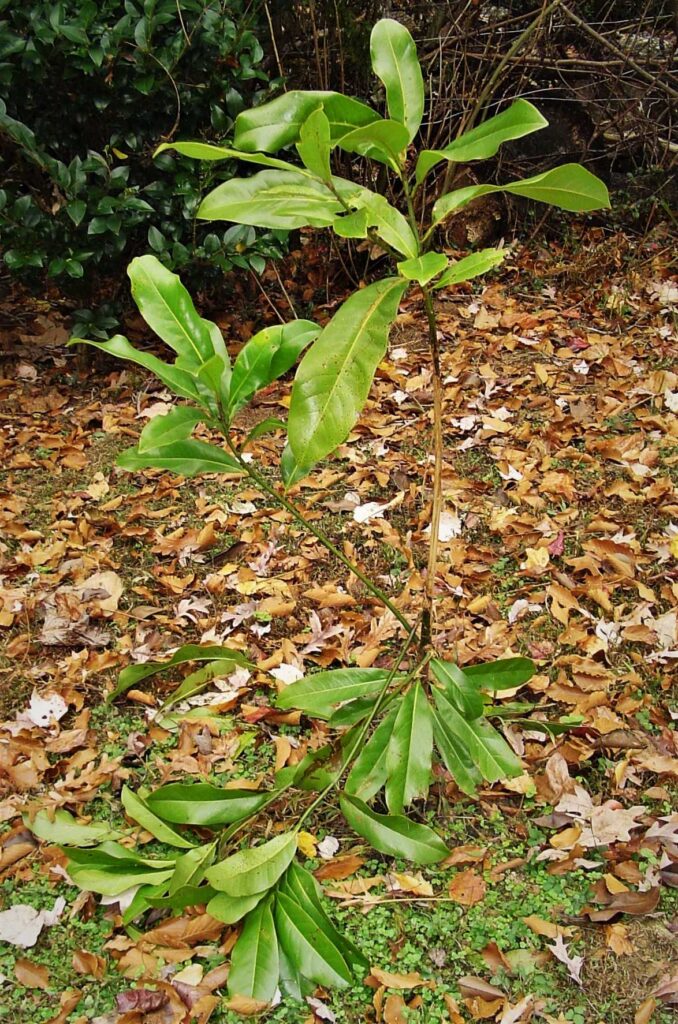
Deer don’t eat Southern Magnolia leaves, but may damage young trees by rubbing their antlers against their bark. This tree survived the damage in November of 2013, and is thriving today.
Many of our native deciduous trees and flowering shrubs are not able to produce enough young seedlings that mature to replace those that are aging or diseased, and so Virginia’s forests are thinning. Open spaces allow invasive species to take root. Those young trees that survive in the gaps often aren’t the desirable native species we want to replace those lost each year. While our mature forests should be made up oaks, hickories, maples, beech, sweetgum, and other native species, we often find privet, Bradford pear, royal Paulownia, and other Asian or invasive species growing into the gaps.
Re-Wilding Efforts Rely on Fences
But this is happening in many places around the world where the population of grazing animals consumes native seedlings before they can mature. One of the greatest obstacles to saving the native temperate rain forests of Scotland, Ireland, Wales, and western England is the livestock grazing on common land including in these forests. Other lands, held by aristocrats, are kept as preserves for deer and bird hunting. These areas, too, are thoroughly grazed so that seedlings cannot grow unless areas are fenced to keep out the deer, sheep, or cattle. Great swaths of these countries are grazed so thoroughly there are only grasslands where forests once grew. Forests are failing to regenerate across the United States, in South America, and elsewhere. This is an important problem as trees are critical to climate regulation of our planet.
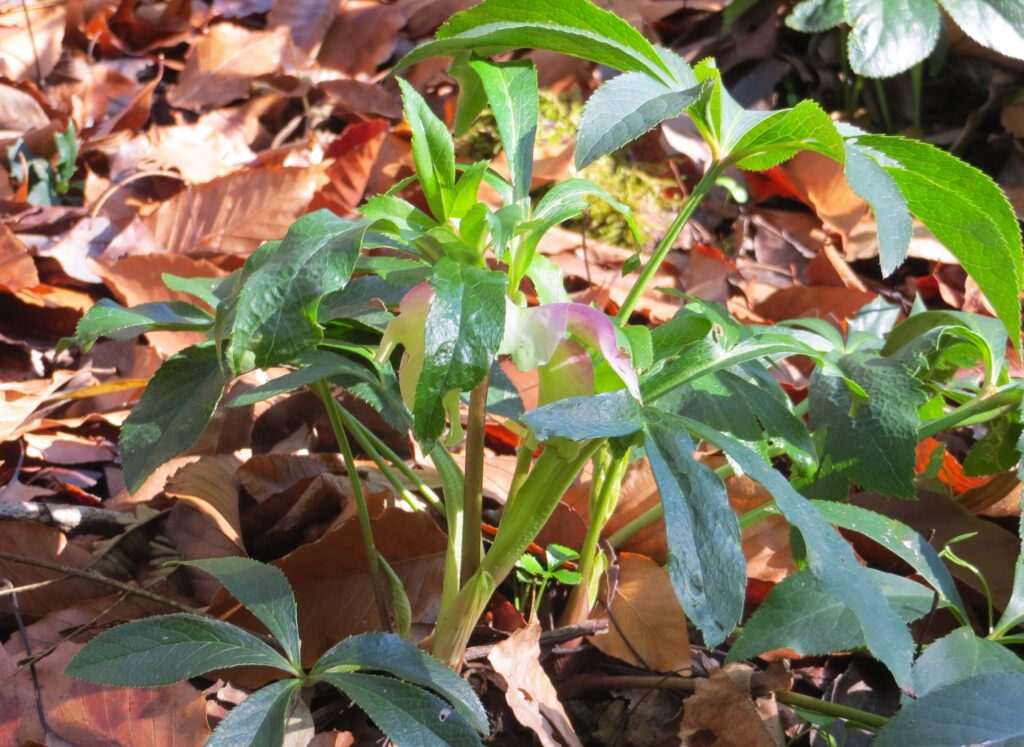
Every part of Hellebores are poisonous, from roots to flowers, which makes them very useful for protecting desirable plants from both voles and deer. These evergreen perennials bloom from December through May, providing nectar for pollinators when little else is in bloom. These plants reseed freely, so remove spent flowers if you don’t want new plants to sprout and enlarge your planting.
Landscaping or Forage?
Deer require plant forage to survive. Each deer eats 3%-5% of its own body weight in living plant material each day. When desperately hungry, deer will try to eat most anything. They no longer adhere to any list of ‘deer-resistant’ or ‘deer-friendly’ plants. While they may prefer tasty native plants, they will forage irrespective of a plant’s provenance. I was once amazed to watch them consume a newly planted hybrid holly hedge in just a few days. The holly’s spiky leaves didn’t seem to matter. Nursery grown plants, full of tasty fertilizer salts, seem to be especially appealing during their first few years of growth. Unfertilized trees and shrubs aren’t nearly as tasty.
Deer also damage lawns and the slopes of ravines while walking on soft, wet, ground. Their pawing can damage grass and mossy areas. They leave scat, which carries a variety of harmful bacteria, in residential yards near children’s play areas and where pets can find it. The herd often wears paths through those areas where they frequently run.
Do deer graze in your garden?
Deer herds keep increasing across most areas of the US, and they are not shy about living in suburbs, small towns, and now even in cities. Deer have adapted to living amongst people, finding food, water, and habitat in areas where they were never seen even thirty years ago. They are smart enough to realize it is quite safe to venture onto porches and patios to graze potted plants, drink from bird baths, and sample the bounty of bird feeders. Most people watch them from a distance, posing no perceived threat to the deer. In fact, some of our neighbors hesitate to come out into their own yards to gather their mail or walk to their car because they are afraid of the deer lounging there.
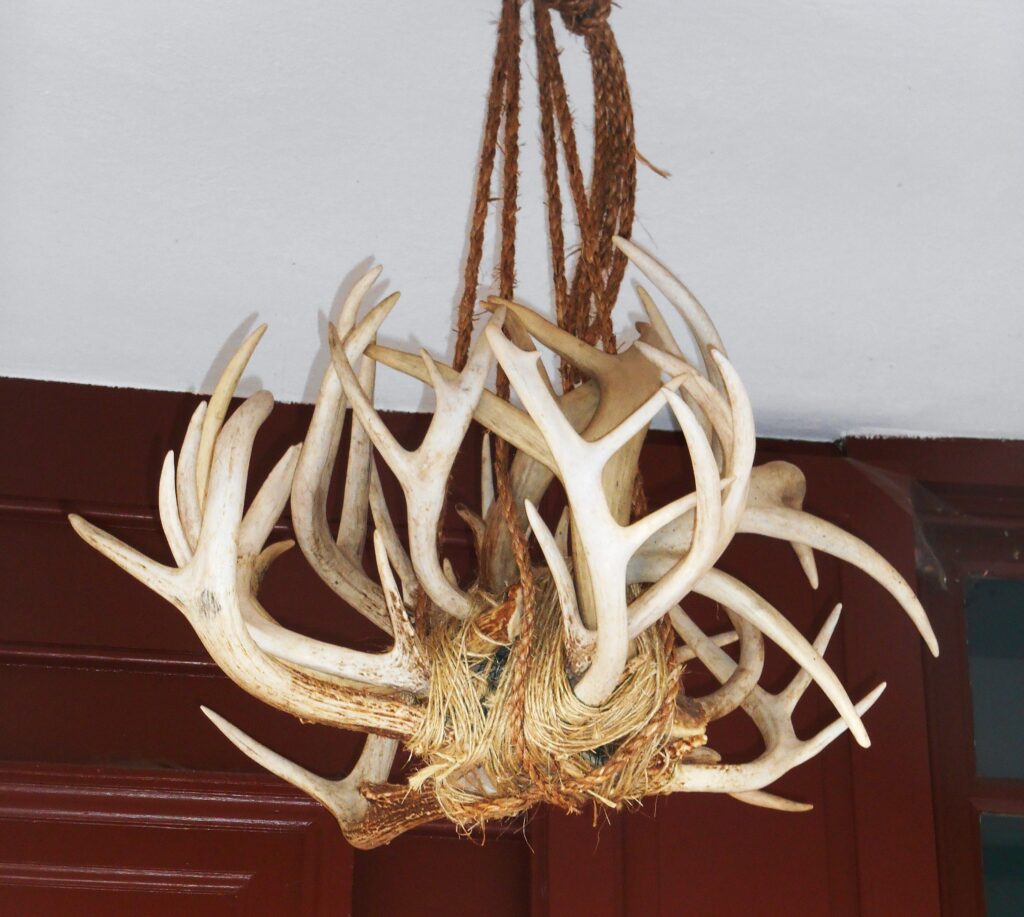
An ornament made from deer antlers was hanging on a Colonial Williamsburg porch, near some deer themed wreathes, in December 2017. Male deer lose and re-grow their antlers each year. Discarded antlers can sometimes be found on walks in the woods.
White-tail Deer’s Importance in Virginia
While native deer were plentiful in Virginia before colonization, Indigenous Americans relied on deer for food, for their hides, and for other raw materials harvested as the deer were prepared for consumption. Deer were subject to continuous hunting, with bow and arrows, which required both skill and patience. There were also natural predators, before colonization, which kept the deer population in balance.
Early Americans also came to rely on deer. Hunting wasn’t regulated, and many families depended on hunting and fishing to feed their children. Virginia’s whitetail deer, Odocoileus virginianus, were nearly extinct by 1900. The native whitetail deer population gradually rebounded after new hunting laws were enacted in the 1930s. State wildlife officials began restocking the deer in some areas, and habitat restoration efforts allowed deer to thrive in areas where they had almost disappeared.
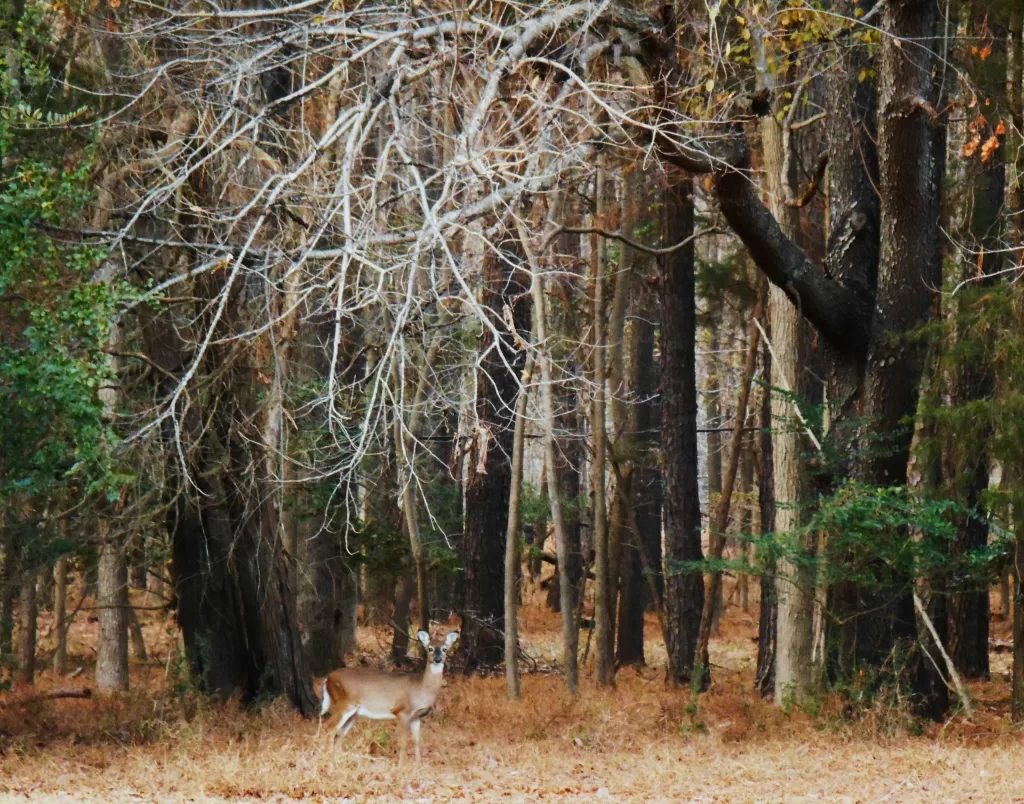
Deer live along the Colonial Parway, near Jamestown. Deer were another important source of winter food for early colonists. Virginia deer hunting season now lasts from September through late March.
The White-tail Deer Population Fluctuates
The deer population can increase very quickly. A doe bears her first fawn when she is less than 2 years old, and she can continue giving birth to four or five fawns each year for the next 8 to 10 years. Twins and triplets are not uncommon. Each buck may have a harem of six or more does in his family group. We sometimes encounter groups of 20 or more deer of various ages feeding in our own or neighboring yards.
According to the Virginia Department of Wildlife Resources, there were around a million wild deer in Virginia in 2023, which is a 4000% increase since 1931 when the population was estimated at 25,000, statewide. State officials estimate that there are twice as many deer in Virginia today as there were in the early 17th century, when Jamestown was founded.
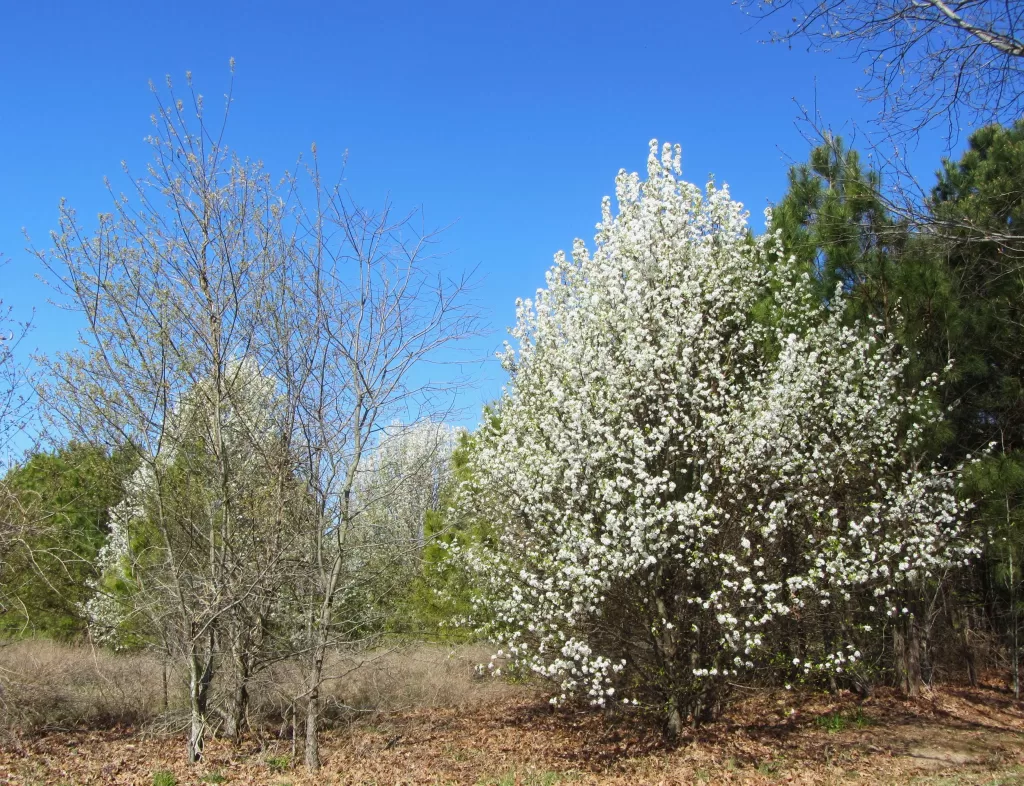
Few desirable native trees survive to maturity in this open stretch on the banks of the James River near Jamestown Island. Blooming Bradford pears, now considered invasive, grow in the open spaces among a variety of pine and red cedar trees.
The deer population has grown so much since the 1990s that state wildlife officials went from trying to restore deer populations to trying to control them. The first Virginia Deer Management Plan was approved in 1999 and updated in 2006. It seeks to manage deer habitat, population size, regulates hunting, and monitors the deer population for disease. Chronic wasting disease, a neurological disorder, can transmit to humans who eat the meat of an infected deer. Neighbors will sometimes find a dead deer in their yard which died due to CWD. Wildlife officials also remain on alert for cases of bovine tuberculosis, hemorrhagic disease, and other, emerging health risks to Virginia’s deer.
The Importance of Responsible Deer Management
Hunters legally harvested nearly 185,000 deer in the 2022-23 hunting season in Virginia, which was slightly less than in previous years. There are fewer hunters now than in years past, which means that deer harvesting no longer can effectively control the deer population. More deer go hungry in winter and fall ill with disease. The deer hunting season, which begins in September, was recently lengthened from January to March to better control the number of deer living in Virginia.
Maybe you, like some of our neighbors, enjoy watching and photographing wild deer. You feel compassion for them and may want to feed them. Please don’t. Feeding deer during hunting season is considered ‘baiting’ the deer and is a criminal offense. It is also illegal in Virginia to keep a wild deer as a pet. We need to let wild animals remain wild. Injured deer should be taken to a licensed wildlife rehabilitator, not cared for at home.
The Financial Impact of Hungry Deer
As charming as you find the deer, maybe you want to grow a vegetable or ornamental garden around your home and find that nearly impossible because the deer eat most everything you plant. Deer cause enormous financial damage to agricultural crops and home food production and landscaping each year. Grazing deer often devastate home vegetable gardens, eating entire plants as well as the ripening tomatoes, squash, and cucumbers. They are especially attracted to fruit trees and berry bushes. While chemical repellents can help, only tall fences more than 7’ high will reliably protect your garden from hungry deer. Many neighborhoods and localities will not allow such tall fences in view of the public.
Ornamental Azaleas, Rhododendrons, and other shrubs that neighbors planted in our neighborhood prior to 1995, which grew well and with little browsing in that era, are now heavily grazed each year as high as the deer can reach. The deer population has increased in our community as nearby lands were developed, ruining their habitat, and as hunting in our region declined.
Let Nature Take Her Course?
Even if you are content to let nature take its course in your yard, and you aren’t an avid gardener; you may be concerned about deer ticks and the diseases they carry. Ticks lurk in places frequented by deer. They wait on grasses, shrubs, and anywhere they can until a warm blooded person or animal comes near enough for them to jump and catch a ride and a meal. Deer ticks are the primary vector for Lyme’s disease, a disease with debilitating, long term symptoms when it isn’t promptly treated. It can remain in your blood and continue causing long-term problems, even after treatment. Doctors say that it takes 24 hours of attachment for ticks to transmit Lyme disease. Any tick bite that forms a red ring, or seems infected, needs medical attention to treat any potential Lyme disease infection.
Hazards to Vehicles
Deer also prove to be a danger to motorists and bike riders on both highways and neighborhood streets. They jump out suddenly from yards, fields, golf courses, and wooded areas into the path of vehicles, especially in the late autumn and winter when rutting bucks are pursuing females. Deer of all ages cause a significant number of accidents resulting in injuries, fatalities, and property damage each year. Inexpensive deer whistles or deer horns, available at auto parts supply and other stores, are easy to install on the front of a vehicle and make an inaudible, high-pitched whistling sound that warns deer to not enter the roadway as your vehicle approaches. University studies of the effectiveness of these devices give mixed assessments.
The Dangers from Deer Increase in Autumn
Male deer can become aggressive during rutting season and pose a danger to pets and people. A fully grown male deer can weigh up to 300 lbs. They run at nearly 40 m.p.h. and can jump over 8 feet high. Bucks range over an average of 600 acres each, and does may range over as much as 200 acres each, with their young close behind. This is one reason why deer frequently cross heavily trafficked areas, darting out in front of cars without stopping to look for traffic.
Late fall and winter are difficult when there is a large concentration of deer in a small area. Food grows scarce and the deer grow hungry, making them more vulnerable to disease. But over-grazing permanently damages habitat and food supplies needed by birds and other small animals, like squirrels, raccoons, possums, rabbits, and foxes. Wildlife populations of other species can crash when they no longer have the food and shelter that they need to survive. Loss of trees, shrubs, and native perennials also impacts the insect and pollinator populations.
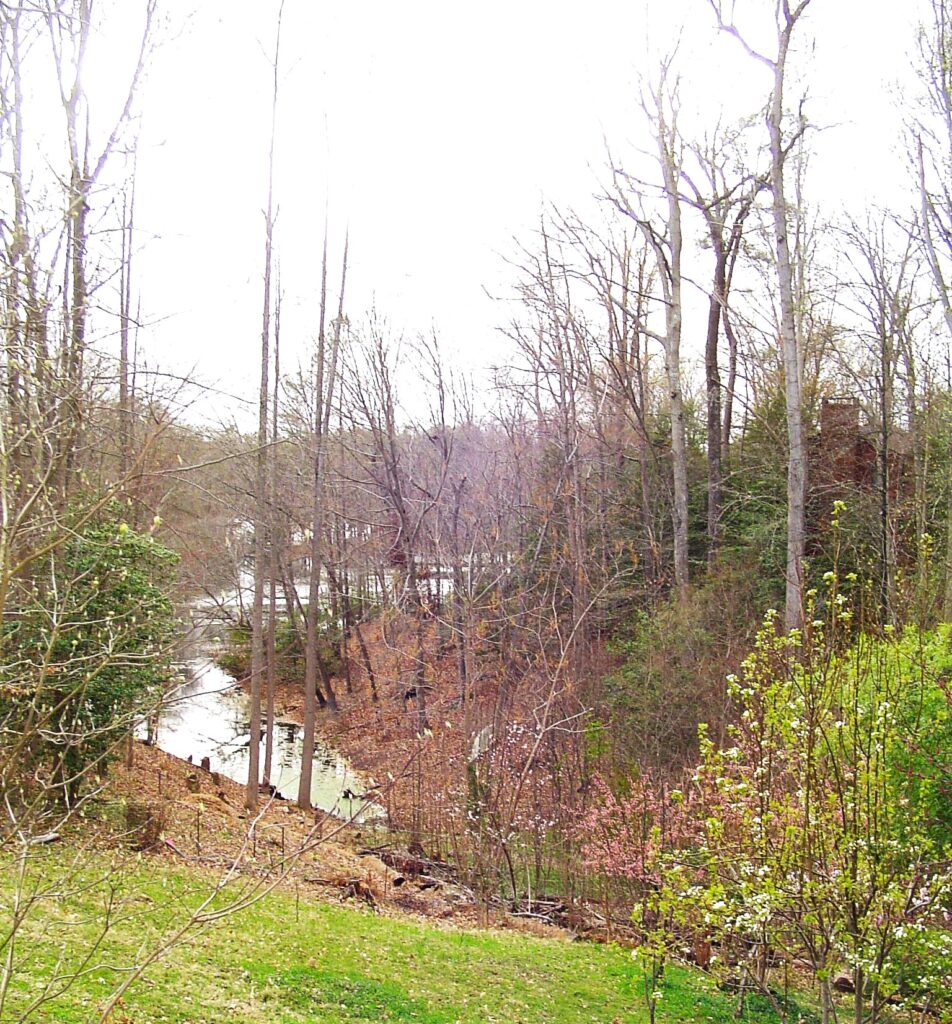
Deer congregate around sources of water, particularly in neighborhoods. Grazing makes it difficult for young native trees to take root and grow to regenerate the forest unless areas are fenced off from deer traffic. April 2010.
Controlling Deer Populations in Neighborhoods
Virginia’s white tail deer, while beautiful and fun to watch, present a problem in neighborhoods across Virginia. There are a variety of ways to manage the deer populations in suburban environments. And there are excellent reasons to encourage deer harvesting by qualified, licensed bow-hunters who help manage the deer population in neighborhoods. Deer not only roam over huge areas, but they are excellent swimmers and thrive in a variety of habitats. Since deer no longer have natural predators in most areas, we need an ongoing program to manage herds as they roam through neighborhoods to and from wilder adjacent areas. Some bow hunters specialize in working with homeowners to safely harvest deer in a specialty known as urban archery. Virginia laws protect homeowners so they aren’t liable for any injuries a hunter sustains while on their land. Bow hunters who work in neighborhoods tend to be extremely safety conscious, working as quietly and unobtrusively as possible.
Feeding the Hungry While Managing Deer
Deer remain an important food source, particularly for those who enjoy wild game, for those in need, and for families who don’t have consistent access to good nutrition. Hunters for the Hungry provided 1.6 million servings of venison to hungry Virginians in 2010. They harvested 407,796 pounds of meat from deer in Virginia humanely, had the meat processed professionally, and distributed it through local food banks and other non-profit organizations that feed the hungry. In 2023, they harvested 185,685 pounds of venison. Their goal is to provide 500,000 pounds of meat to hungry families in Virginia annually.
Hunters working in local neighborhoods generally donate a portion of the deer they harvest, so hungry families have meat, while ensuring that the deer population is managed responsibly. Hunters routinely work closely with state wildlife officers and staff. They render an important public service to homeowners by managing the deer population, while they also help feed those who need the meat. Homeowners can assist by allowing access to their properties, particularly those who have waterfront property or who live on ravines frequented by herds of deer. Homeowners, and others concerned about hunger in Virginia, can also contribute financially to Hunters for the Hungry to help with the costs of processing and distributing the meat.
Additional Ways Homeowners Can Manage Deer and Help Restore the Environment
In addition to allowing bow hunters access to hunt, there are a number of other things homeowners can do to help heal the environmental damage caused by deer:
- Allow seedling native trees to grow in your yard, protecting them with tree guards or wire cages for their first three or four years of growth.
- Closely plant trees in ‘guilds’ of a variety of trees, shrubs, and perennials so that if a few are grazed or damaged, others in the group will continue growing. Underplant your group of trees with ground cover plants that may offer some protection by keeping deer at a distance. Strongly scented plants like members of the onion family, including chives; mints; rosemary and other Salvias; Pachysandra species; and poisonous Helleborus species can help keep deer at a distance. It is wise to enclose the entire guild with a fence or cage to keep deer out of the planting during the first two or three years of growth.
- Plant a mixed species hedgerow, or living fence, of woody species that deer won’t graze to form a natural barrier around areas of your property that you want to protect from deer. Include shrubs with thorns or prickles and species known to be poisonous to deter grazing. A hedgerow also provides shelter and food for a variety of birds and small animals that have otherwise lost habitat and forage to deer grazing. This is a good way to ‘re-wild’ and regenerate land that has been compromised by development.
- Plant, or encourage seedlings, of trees that deer rarely graze: conifers like Eastern red cedar and native pines; poisonous scarlet buckeye; pawpaw trees; native holly or Ilex opaca and I. vomitoria; and sumac, or Rhus species. While mountain laurel is highly poisonous, deer will sometimes graze those leaves they can reach. Other trees resistant to deer grazing include Southern Magnolia with its thick, glossy leaves; American sweetgum with its corky stems and thick resin; and fragrant wax myrtle, or Myrica species.
- Choose Asian shrub species with thick leaves or prickles which prove resistant to grazing. Chinese and Japanese hollies; boxwood; Pyracantha, known as firethorn; Berberis species (formerly Mahonia); and Osmanthus species. Many ‘invasive’ plants like privet and members of the olive family are rarely grazed. Perhaps this is a reason why they have proven so popular with landscapers over the years.
The Price of Success, or, Be Careful What You Wish For….
The population of white-tailed deer in Virginia has grown exponentially over the past several decades as deer have adapted to living among people, and as hunting has declined. Deer now cause a wide range of health, safety, and environmental problems. Their impact prevents the normal regeneration of woodland plant species and destroys food sources and habitat for wild birds and other animal and insect species.
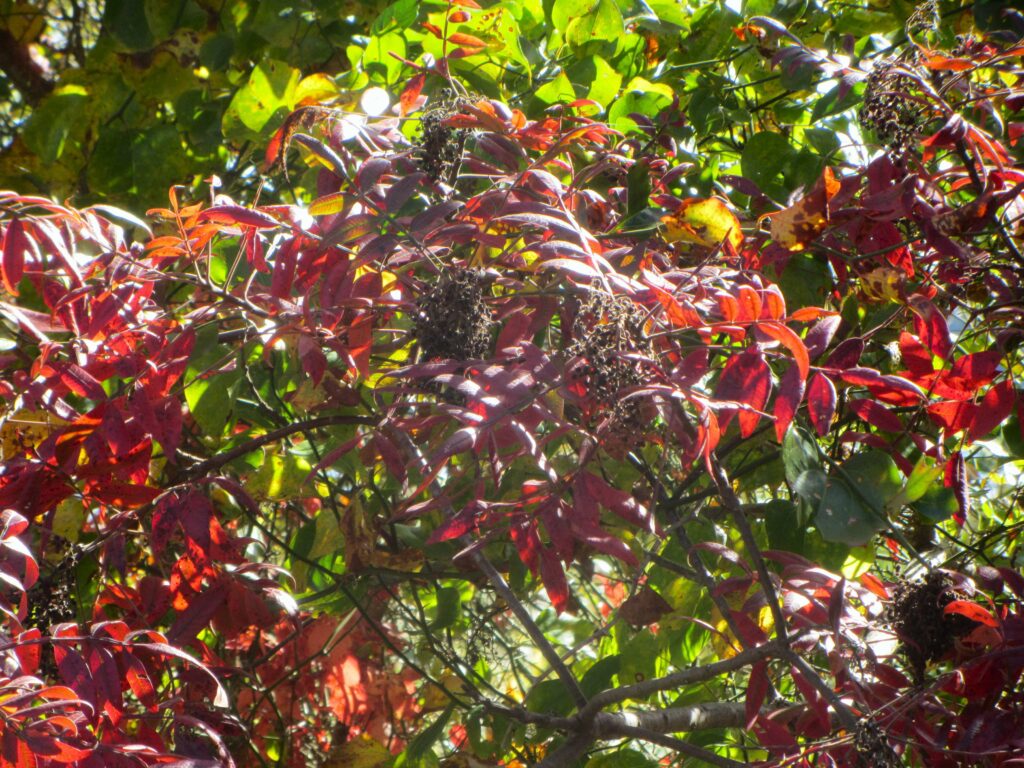
Sumac, Rhus spp., grows wild in coastal Virginia. While the berries of some species are edible, deer rarely touch Sumac. Sumac forms thickets and is excellent for holding slopes and forming barriers.
Meeting the Challenges
Since there is no governmental program to control the deer population through official culling efforts, we are all dependent on private, licensed hunters to hunt each winter and so control the growth of local deer herds. Bow hunting within neighborhoods is legal in Virginia and is considered safe when done appropriately. Hunters who use firearms harvest more deer each year than bow hunters, but must work in rural areas and are not allowed to work within set limits of occupied dwellings. They are not able to help control deer living within suburban and urban neighborhoods.
This means it is up to local gardeners to both support local bow hunters and also to adjust their plantings to discourage deer from grazing in their yards. Fences and chemical repellents can help to protect plantings to some extent. But as the number of deer continues to increase, so will their environmental impact as they search for food. This is a challenge we must resolve as a community, and in a variety of ways to address the many impacts of deer living in our neighborhoods.
All photos by E. L. McCoy
Other Related Posts on This Site:
The Susceptibility of Plants to Deer Damage










